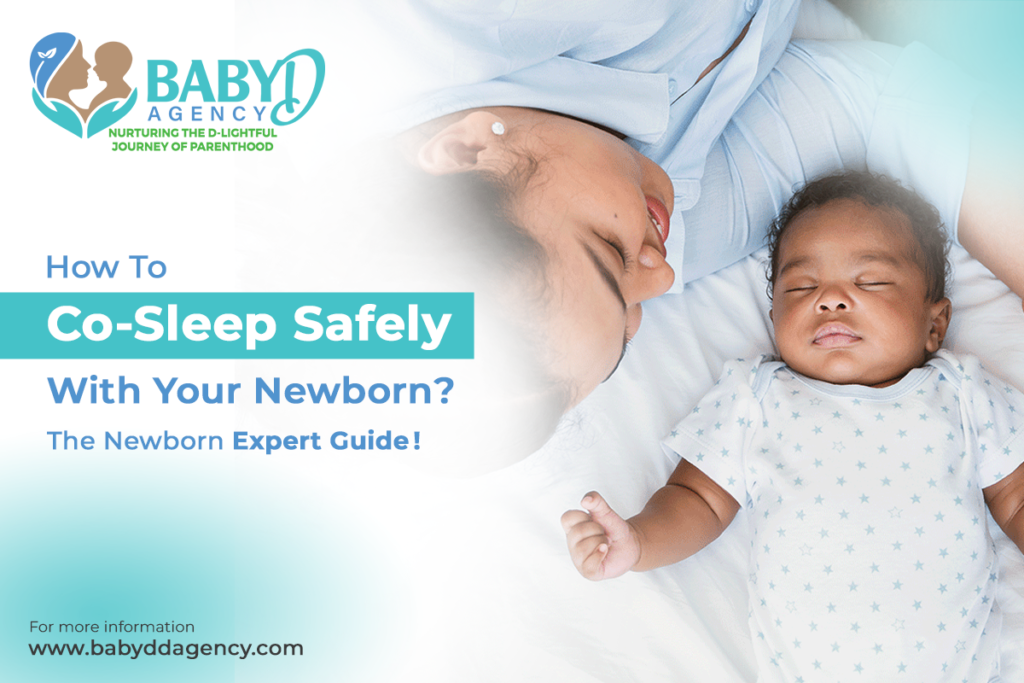Co-sleeping with your newborn can be a beautiful experience, fostering closeness and making nighttime feedings more convenient. It is no new practice, but for recorded history, parents use this sleeping technique for a safer baby sleep routine.
For new parents, this technique can foster a more peaceful, nurturing night of rest for both parents and the newborns.
Do you know anything about this technique? Well, to make things understandable, you should get a newborn care specialist 24*7.
Apart from this, we the newborn care experts, who are moms, have offered essential tips and positions for newborn co-sleeping to help you create a safe and nurturing environment for your baby.
What Is Co-Sleeping?
Co-sleeping, where parents and newborns share the same sleeping space, is practiced worldwide and can offer numerous benefits. It promotes bonding, makes breastfeeding easier, and allows parents to respond quickly to their baby’s needs. However, it also requires careful consideration to ensure safety.
The different types of Co-sleeping include-
- Room-sharing is the process where an infant or toddler shares a room with you and sleeps in a crib or bed. Your kid should spend the first six months of their life sleeping in your room, both during the day and at night.
- Bed-sharing is when you and your infant share a bed.
- Side sleeping is when a youngster naps next to you in a cot that is fastened to your bed.
Essential Safety Tips for Co-Sleeping
- Create a Safe Sleep Space
Safe sleep space makes the newborn sleep more deeply. Also, with a safe space you can get the best rest without any worry.
Some tips here to create a safe space are-
- Use a firm mattress: A firm mattress provides a stable and safe surface for your baby to sleep on, reducing the risk of suffocation.
- Avoid soft bedding, pillows, and blankets: These items can pose a suffocation hazard. Instead, keep the sleep space minimal and clear of any objects.
- Ensure the bed is free of gaps or spaces: Check that there are no gaps between the mattress and the headboard, footboard, or wall where the baby could get trapped.
- Place the baby on their back to sleep: Always position your baby on their back to reduce the risk of Sudden Infant Death Syndrome (SIDS).
- Avoid Risk Factors: Several factors can increase the risk of co-sleeping. Try to avoid it for your baby’s safety. Ensure that the sleep environment is free from these hazards.
Some common areas that you can avoid-
- Do not smoke, consume alcohol, or use drugs: These substances can impair your awareness and responsiveness, increasing the risk of accidents.
- Keep pets and older siblings out of bed: Pets and older children can inadvertently roll over or disturb the baby, creating unsafe conditions.
- Temperature Regulation
The temperature of your room is mandatory to check. It can hamper or give a sweet sleep for your newborn.
Some factors you can consider-
- Dress the baby in lightweight sleepwear: Overheating can be dangerous for newborns. Dress your baby in light, breathable fabrics.
- Maintain a comfortable room temperature: Aim for a room temperature that feels comfortable for a lightly clothed adult, typically between 68-72°F (20-22°C).
- Use a sleep sack instead of blankets: Sleep sacks are a safe alternative to blankets, keeping your baby warm without the risk of suffocation.
Preparing for Safe Co-Sleeping
- Educate Yourself
Understanding the principles of safe co-sleeping is crucial. Enroll in a newborn care specialist certification course to learn about the best practices and safety guidelines.
- Seek Professional Guidance
Consulting with a newborn care specialist can provide personalized advice tailored to your family’s needs. They can help you create a safe co-sleeping setup and address any concerns.
- Monitor Your Baby’s Sleep Patterns
Keep an eye on your baby’s sleep patterns and adjust your co-sleeping setup as needed. As your baby grows, their needs may change, and you should be flexible in adapting to these changes.
Know The Sleeping Positions For Newborn Co-sleeping
Side-Lying Position
- Baby lies on their back beside the mother: This position allows the baby to have their own space while being close enough for the mother to monitor.
- Mother lies on her side facing the baby: This proximity makes it easy for the mother to nurse and comfort the baby during the night without having to get out of bed.
- Allows for easy breastfeeding and quick responses: Mothers can easily tend to their baby’s needs, promoting bonding and ensuring the baby feels secure.
Co-sleeper or Bedside Bassinet
- Baby has a separate sleeping space attached to the parents’ bed: Co-sleepers provide a safe, dedicated space for the baby while keeping them within arm’s reach.
- Combines proximity and safety: This arrangement allows parents to have their baby close by without sharing the same sleep surface, reducing the risk of accidental smothering.
- Ideal for parents who move a lot during sleep: If parents tend to move around in their sleep, a co-sleeper ensures the baby remains safe and undisturbed.
“C” Position for Bed-Sharing
- Mother curls her body around the baby: The mother’s body creates a protective barrier around the baby, keeping them secure.
- Arm above the baby’s head and knees bent below the baby’s feet: This position helps prevent the baby from moving up or down the bed.
- Prevents the baby from moving up or down the bed: By creating a physical boundary, this position helps keep the baby in a safe and stable spot throughout the night.
Regularly Check the Sleeping Environment
- Ensure the sleeping area remains safe and free from hazards: Regularly inspect the bed to make sure there are no loose bedding or other hazards that could pose a risk to the baby.
- Adjust as necessary: As your baby grows and becomes more mobile, continue to adapt the sleeping environment to maintain safety.
The Role of BabyD Agency in Safe Co-Sleeping
Expert Guidance from BabyD Agency
BabyD Agency offers expert guidance for parents who choose to co-sleep with their newborns. Their newborn care specialists are trained to provide personalized advice and support, helping you create a safe and nurturing sleep environment for your baby.
Comprehensive Support
From newborn care specialist certification to practical tips and techniques, BabyD Agency ensures you have all the resources needed to co-sleep safely. Their best newborn care tips can help you navigate the challenges of co-sleeping, ensuring that both you and your baby enjoy restful and safe nights.
Conclusion
Co-sleeping with your newborn can be a rewarding experience when done safely. By following these essential tips and seeking guidance from professionals like those at BabyD Agency, you can create a secure and nurturing environment for your baby. Remember, the key to successful co-sleeping is education, communication, and flexibility. Embrace this special time with your baby, knowing that you are providing the best care possible.

